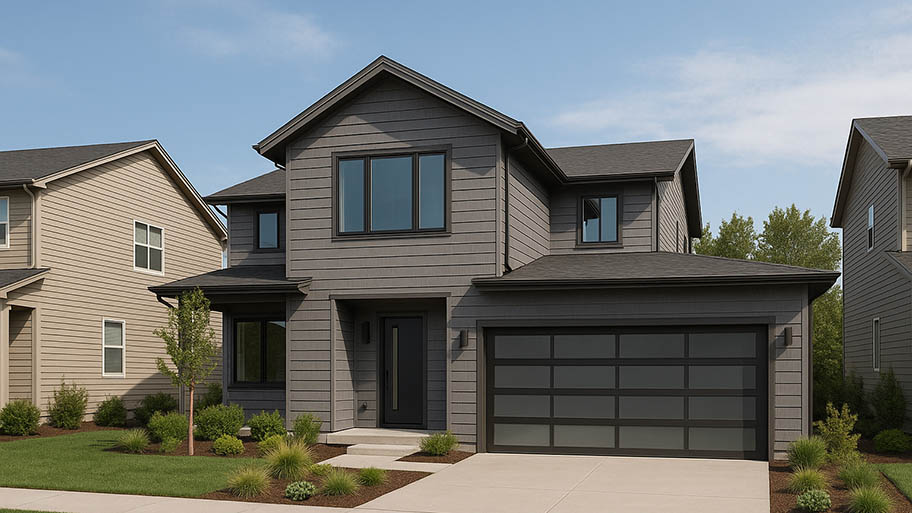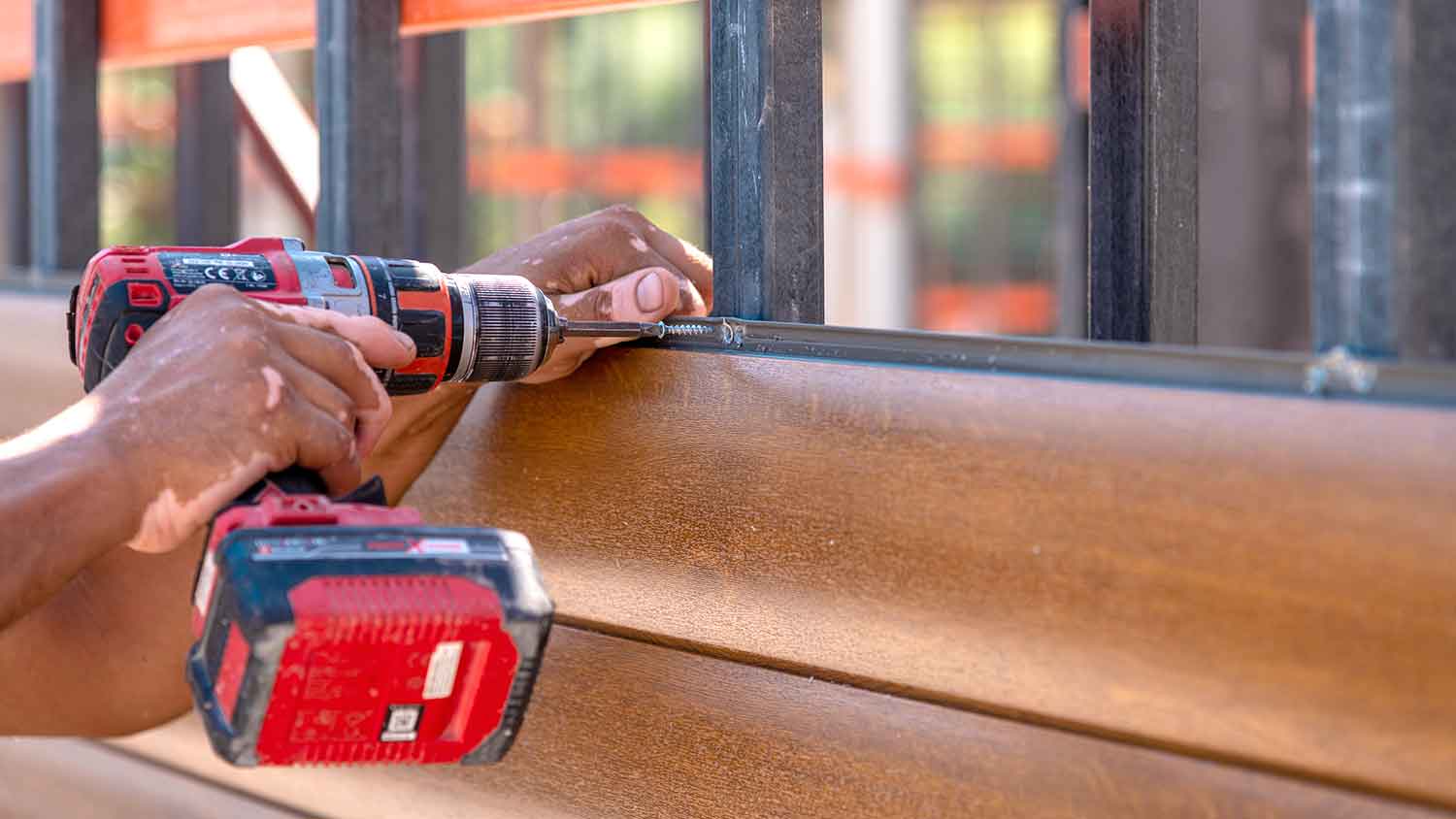
Cedar, pine, cypress, or fir—wood siding is a durable and elegant choice for the outside of your home. Here are the wood siding costs to expect.
Get to know the Frankenstein of siding


Composite siding is made using a blend of different fibers, resins, and more.
Using recycled materials, composite siding is an environmentally-friendly option.
Composite siding requires little maintenance, but has a higher upfront cost than vinyl.
While composite siding comes in a range of colors and styles, it has a tendency to fade, and will need repainting every five years.
Composite siding is a wood-like, exterior siding created by mixing wood fibers, sawdust, and wood scrap to create manufactured boards. It can be made with resins, fiberglass, and other plastic materials, which helps it withstand harsh weather, moisture damage or rot, and attacks from insects.
Composite siding is a popular option for those who live in areas with extreme weather patterns, where wood and vinyl siding would be high-risk choices. It’s easy to paint or repaint and installation is a breeze. However, it’s more expensive than simpler siding types, and quality can vary significantly between manufacturers so it’s important to find a good supplier.
Check out the benefits and drawbacks of installing composite siding.
| Composite Siding Pros | Composite Siding Cons |
|---|---|
| Low maintenance | Initial costs |
| Durability | Visible seams |
| Design options | Affordability |
| Easy installation | Fading frequency |
| Easily painted | Quality control |
| Energy efficient |
Composite siding has many benefits—most homeowners love that it comes in so many colors and styles, allowing a perfect match for any home.
Solid wood requires painting and staining to give it an added layer of protection—this isn’t necessary with composite siding. You can save money and time on maintenance costs.
Composite siding boards are designed with interlocking components that make installation easier, allow the boards to respond to temperatures, and resist pest or moisture problems.
Since composite boards aren’t made of pure wood, they don’t attract bugs like termites as some siding can, and they’re significantly more resistant to rot. That makes composite boarding a great alternative in humid or rainy climates. Plus, the synthetic design is usually fire resistant.
Available in a wide range of colors and styles, composite siding can match your home’s look and your design preferences. In fact, you can opt for a style that mimics the look of real wood.

Because composite siding is so lightweight, installation is usually easy and quick without requiring any heavy machinery.
Another benefit of manufactured boards is that they’re easy to paint. Homeowners can often take care of exterior siding paint projects and easily update to a new paint shade with minimal fuss. Easily-paintable surfaces can prevent problems that lead to flaking, so you don’t have to plan repainting maintenance as often (around five years for the best results).
Composite siding is thick enough to insulate a home more than some alternatives, like vinyl siding. Its energy value is also closely connected to how easy it is to install. Choosing composite siding makes it simple to add moisture barriers and insulation to your exterior walls as part of the project, making homes with poor insulations much more efficient.
Nothing is perfect. Composite siding does have some downsides, which you should be aware of before you purchase it for your home.
When compared to alternatives like oak or vinyl siding, composite siding is more expensive, and professional installation may cost more. That can give homeowners pause if they’re on a tight budget. While composite siding recoups some of its costs over the years with durability and simpler maintenance needs, the starting costs will still be higher.
Some homeowners may not like the fact that you can see the seams between panels when looking at them from certain angles or in brighter light.
While composite and engineered wood siding is less expensive than wood siding, it’s not the most budget-friendly option on the market. Vinyl, steel, and aluminum tend to be friendlier on the wallet.
Over time, composite siding exposed to a lot of sunlight can lose its color. This won’t affect your siding’s durability, but you might be frustrated if you care about your siding’s color matching your home.
The resins and adhesives used in composite siding can be hazardous. That’s not usually an issue, but it is a problem during installation when professionals are sawing composite boards. Also, those same materials aren’t very biodegradable, so it’s not an eco-friendly choice like wood siding.
Composite siding’s quality depends greatly on what materials are used and how well those materials are manufactured into boards. That means there’s a big difference between low-quality results that easily fall apart and high-quality composite siding from the best manufacturers.
Composite siding is one excellent siding option, but you’ll need to weigh various factors before deciding on your siding material. Consider the following, and speak to a siding contractor near you to get a professional opinion on the materials available for your home.
Weather and Climate: Composite and engineered wood siding has excellent insulative properties, which make it a good option in colder climates, but fiber cement is more durable, which some prefer if they are battling extreme weather year after year.
Budget: If you’re concerned about budget, you’ll want to look at vinyl, aluminum, and steel, though composite siding is only slightly more expensive than these options. It’s important to weigh long-term costs as well—composite siding is more durable than vinyl, so even if there are higher up-front costs, you might pay less down the road.
Aesthetics: You may not like the look of engineered wood or composite for your siding and prefer stone veneer siding—stone veneer is another siding option to consider. That said, it’s worth exploring the many options of composite siding, as one of its benefits is that it is manufactured in a range of styles, such as board and batten.
Pests and Critters: If you live in a more rural area with a higher number of pests and critters, you might consider which siding options are insect-resistant. While composite siding offers strong protection, fiber cement is basically impervious to termites, squirrels, and woodpeckers.
Composite siding can be confused with a few other types of manufactured siding. Let’s look at the most common siding options and the key differences between them.
Engineered siding is the most similar to composite siding, and some manufacturers list it as a type of composite siding. However, there are a few important differences. First, it’s made entirely or mostly from real wood, while composite siding is made of combinations of wood fiber, plastic, resin, and other materials. The focus on wood strands makes engineered siding look and act more like real wood siding.
In addition to looking more natural, engineered siding is often a low-cost option, and it’s easy to install. However, it does lack some of the convenience, weather resistance, and longevity of composite siding.
Fiber cement siding is manufactured like composite siding, but with different materials. It’s made from wood fibers, sand, and cement materials compacted into durable boards. Fiber cement siding is extremely weather resistant, making it a popular alternative to composite siding in areas that experience harsh weather. It’s immune to rot, insect damage and much more.
But fiber cement boards have their drawbacks, too. They are heavy, and cannot be cut with ordinary saw blades like composite or wood siding. That means that installation is rarely a DIY project, and labor costs are often significantly higher. The boards themselves also cost more than alternatives.
Vinyl siding is made of inexpensive vinyl materials that can come in any color. They tend to be the least expensive siding option, especially compared to composite siding. However, these lightweight boards run into problems during harsh weather. In freezing temperatures, vinyl siding can become brittle and easily damaged, while high heat in direct sunlight can warp it. It’s best used in milder climates.
From average costs to expert advice, get all the answers you need to get your job done.

Cedar, pine, cypress, or fir—wood siding is a durable and elegant choice for the outside of your home. Here are the wood siding costs to expect.

Considering a home exterior makeover with cladding? Find out the average house cladding cost to help you plan your budget.

Typical stone siding costs can surpass $100K, but the huge ROI potential may be worth the investment. Get the full cost breakdown of labor and materials here.

Regularly cleaning vinyl siding helps your house look better and last longer. Find out how you can tackle this DIY project on your own.

Clapboard siding is classic, reliable, and hardy, but these wooden boards can get damaged in poor conditions. Here’s how to do a DIY repair for clapboard siding.

Knowing the differences between fiber cement and vinyl siding can help you choose the right one for your home. Our guide explores these two siding choices.